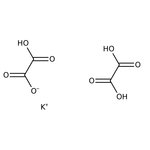Search Thermo Fisher Scientific
Thermo Scientific Chemicals
Potassium trihydrogen dioxalate dihydrate, 98+%
CAS: 6100-20-5 | C4H3KO8 | 218.16 g/mol
Catalog number ALFA14933.30
View Price:Sign InSign in to see your account pricing. Need an account? Register with us today.
Quantity:
250 g
Specifications
Chemical Name or MaterialPotassium trihydrogen dioxalate dihydrate
CAS6100-20-5
Health Hazard 1H302+H312
Health Hazard 2GHS H Statement
H302-H312
Harmful if swallowed.
Harmful in contact with skin.
H302-H312
Harmful if swallowed.
Harmful in contact with skin.
Health Hazard 3P264b-P270-P280-P301+P312-P302+P352-P312-P330-P363-P501c
View more
Potassium trihydrogen dioxalate dihydrat is used in metal polishing determination of pH. And it is also used in photography, marble grinding, and to remove ink stains.
This Thermo Scientific Chemicals brand product was originally part of the Alfa Aesar product portfolio. Some documentation and label information may refer to the legacy brand. The original Alfa Aesar product / item code or SKU reference has not changed as a part of the brand transition to Thermo Scientific Chemicals.
Applications
Potassium trihydrogen dioxalate dihydrat is used in metal polishing determination of pH. And it is also used in photography, marble grinding, and to remove ink stains.
Solubility
Soluble in water
Notes
Store away from strong oxidizing agents. Keep container tightly closed. Store in cool, dry conditions in well sealed containers.
Potassium trihydrogen dioxalate dihydrat is used in metal polishing determination of pH. And it is also used in photography, marble grinding, and to remove ink stains.
Solubility
Soluble in water
Notes
Store away from strong oxidizing agents. Keep container tightly closed. Store in cool, dry conditions in well sealed containers.
RUO – Research Use Only
General References:
- T. Honda.; K. Murase.; T. Hirato.; Y. Awakura. pH measurement in the vicinity of a cathode evolving hydrogen gas using an antimony microelectrode. Journal of Applied Electrochemistry. 1998, 28, (6), 617-622.
- Hong Wen.; Tonglei Li.; Kenneth R. Morris.; Kinam Park. How Solvents Affect Acetaminophen Etching Pattern Formation: Interaction between Solvent and Acetaminophen at the Solid/Liquid Interface. J. Phys. Chem. B. 2004, 108, (7), 2270-2278.



